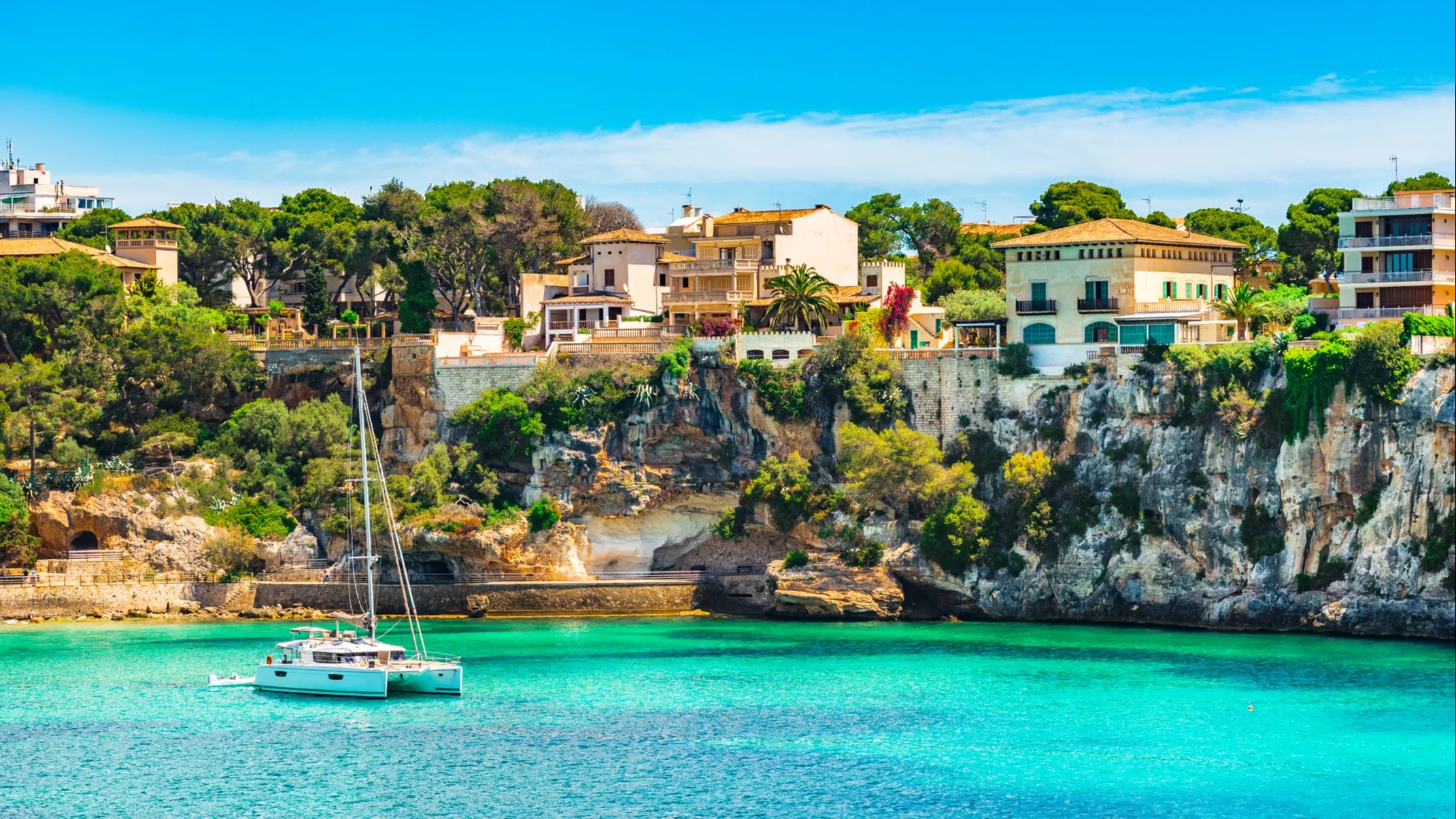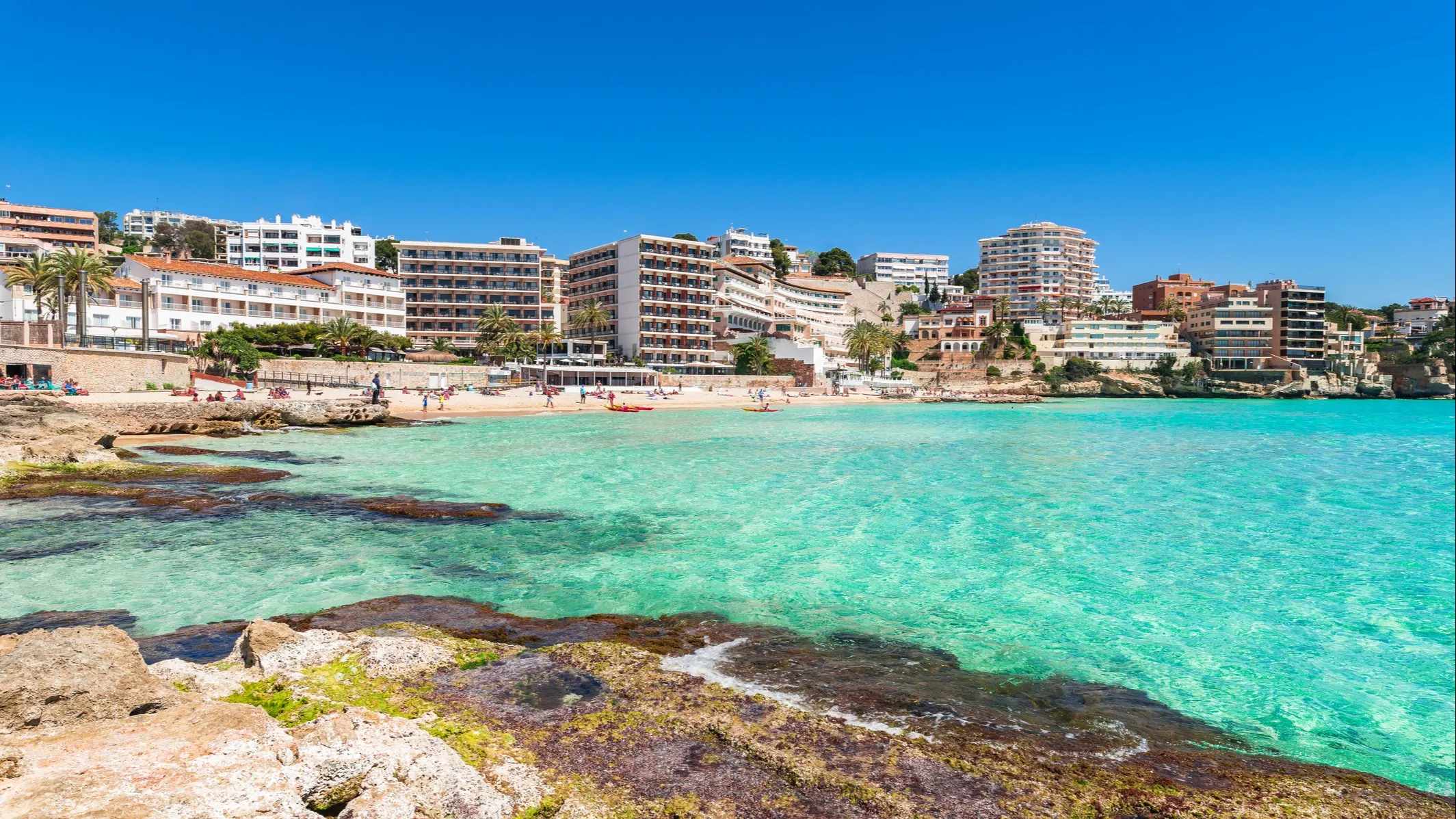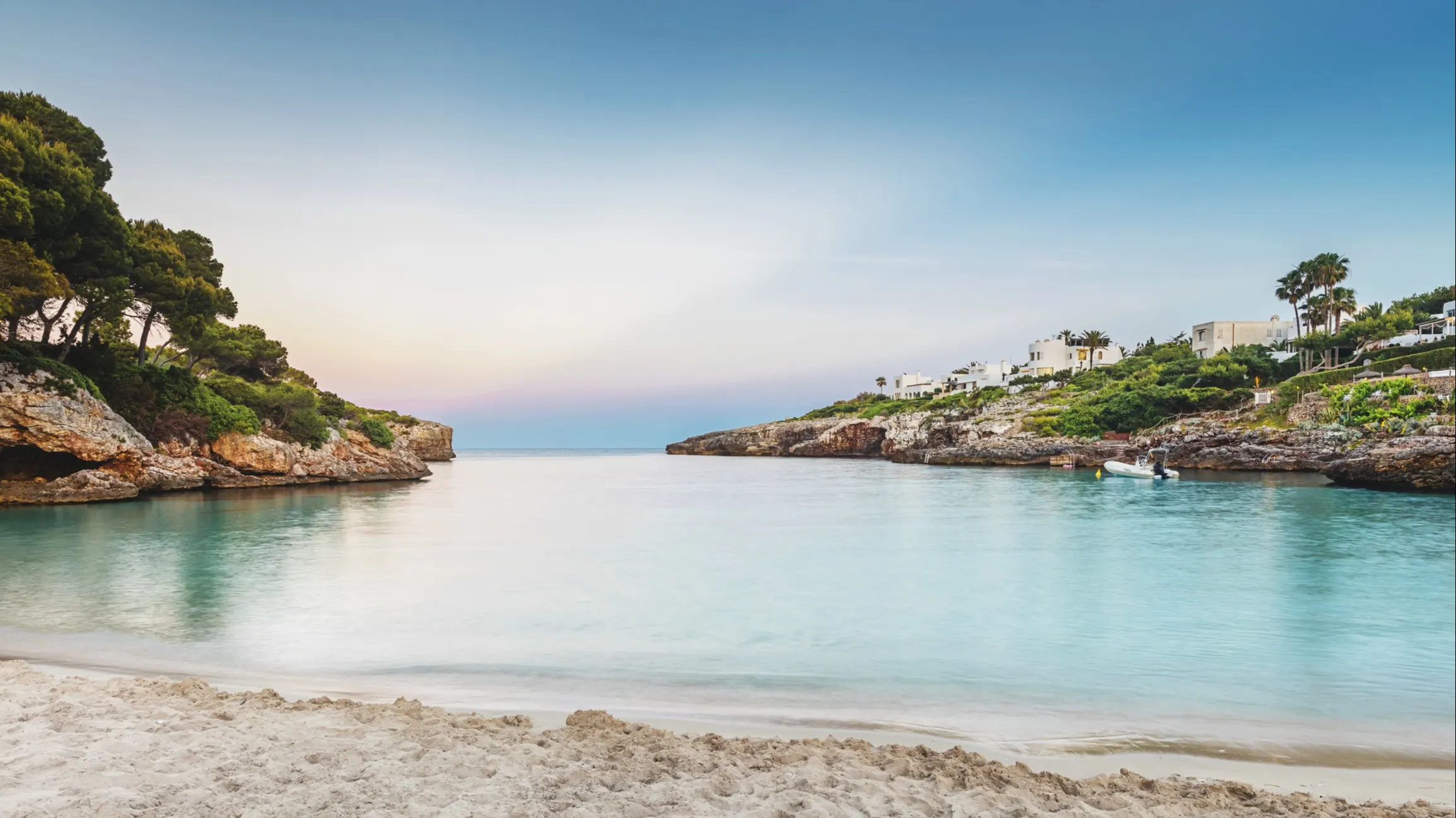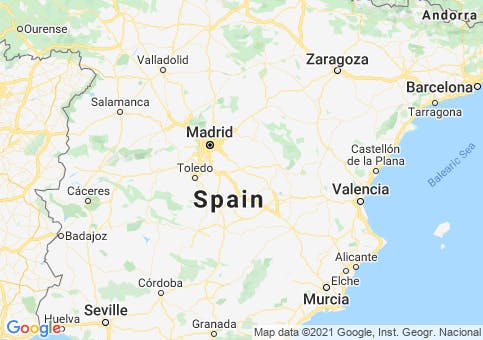For many, the real estate in Spain is the stuff that dreams are made on. Picture a stone farmhouse amidst the vineyards… a white-washed cottage surrounded by olive groves… a chic apartment whose balcony looks out on a centuries-old town square, bustling with cafes… With beaches, mountains, and fabulous cities, Spain has plenty to choose from:
Costa Dourada
The Catalan Coast south of Barcelona offers city amenities, small-town feel, and miles of beautiful urban beaches. A string of charming, small towns lines this coast… towns with colorful plazas, pedestrian-only centers, and plenty of local shops and restaurants. Yet the metropolis—Barcelona—can be as little as 20 minutes away on suburban trains. The climate is mild—and even when it’s too chilly for wintertime swimming, it’s warm enough for the sunny outdoor cafes.
Property Samples on the Costa Dourada:
In pretty Castelldefels, just 20 minutes from Barcelona, a 700-square-foot apartment with balcony in the city center, close to shops, is selling for €105,000 ($136,500).
Granada
The Alhambra, Granada’s famous rose-red citadel, bears an enigmatic inscription that translates as: “Give him alms, woman, for there is nothing in this life so cruel as to be blind in Granada.”
Baking under Andalusian skies, Granada taps into the emotions as well as the senses. It bridges the worlds of Islam and Christianity, meshing together Jewish and Gypsy traditions along the way. With the Sierra Nevada mountains as a backdrop, it’s difficult to envisage a more dramatic setting for a city. Or a sultan’s palace…
The Alhambra’s fortress-palace complex was built mostly in the 13th century. A $15 admission fee gives you entrance into a lost world of passion, intrigue, and tragedy. But there’s far more to Granada than a palace. It’s a city you simply must visit.
Get Your Free Spain Report Today!
Get Your Free Spain Report Today!
Get more information about Spain and other countries in our free daily postcard e-letter. Simply enter your email address below and we'll also send you a FREE REPORT — Live the Good Life in Sunny, Affordable Spain.

By submitting your email address, you will receive a free subscription to IL Postcards and special offers from International Living and our affiliates. You can unsubscribe at any time, and we encourage you to read more about our Privacy Policy.
Property Sample in Granada:
In Granada’s old center, the Albayzin, a 538-square foot, one-bedroom/one-bathroom apartment is selling for €90,000 ($117,000).
Buying real estate in Spain is divided in three phases:
Making an offer
Entering in a private contract
Completion
The private contract should contain details of the agreed deposit payment, purchase price, and details for payment of the outstanding balance of the agreed buying price plus any additional extras and your intended completion. A notary will prepare the official contracts and make sure it complies with Spanish regulations. Any property sale or purchase in Spain should be registered in the Land Registry, and it’s important to make sure any relevant taxes are paid before this is done.
Buying restrictions
There are no restrictions for foreigners buying real estate in Spain.
Get Your Free Spain Report Today!
Get Your Free Spain Report Today!
Get more information about Spain and other countries in our free daily postcard e-letter. Simply enter your email address below and we'll also send you a FREE REPORT — Live the Good Life in Sunny, Affordable Spain.

By submitting your email address, you will receive a free subscription to IL Postcards and special offers from International Living and our affiliates. You can unsubscribe at any time, and we encourage you to read more about our Privacy Policy.
Why Should You Consider Buying Property In Spain?

Beaches…mountains…fabulous cities…cracking festivals. And, of course, guaranteed sunshine.
It’s not surprising that southern Spain is the most popular region for Europeans seeking a home overseas. How much for a home here? Well, there’s a huge price variation across the 17 regions…and also from town to town within the regions. However, since the overheated real estate market crashed to an abrupt halt four years ago, few properties have changed hands, and many real estate agents are retraining in new professions. But if you are determined, you can find a range of attractive homes—from 18th-century stone village houses to modern sea-view properties, including summerhouses and apartments with pools and nearby beach access for about 40% less than you would have paid years ago.
A Step-By-Step Guide To Purchasing Property In Spain

When shopping for property in Spain, take your time. Some properties sell within a month, but others can linger on the market for a year—often because owners are seeking unrealistic sums.
Away from the popular Costas, English isn’t as widely spoken as you might expect. Real estate agents will happily give you listings, but with rock solid local interest, they can afford to ignore the language skills needed to attract international clients. Further complicating matters, most people in Catalonia use Catalan rather than standard Spanish. Signs don’t point to la playa (the beach). Here it’s la platja. The same applies to the Basque Country on Spain’s northern Atlantic coast, where many people speak Basque. Otherwise, the purchase process is fairly straightforward.
Get Your Free Spain Report Today!
Get Your Free Spain Report Today!
Get more information about Spain and other countries in our free daily postcard e-letter. Simply enter your email address below and we'll also send you a FREE REPORT — Live the Good Life in Sunny, Affordable Spain.

By submitting your email address, you will receive a free subscription to IL Postcards and special offers from International Living and our affiliates. You can unsubscribe at any time, and we encourage you to read more about our Privacy Policy.
Step 1: Make an Offer
Once a property has been chosen, the first step is to make a verbal offer. You may wish to make this offer conditional to being able to obtain a mortgage. In a typical transaction for resale property, you put down an initial deposit ($3,600 to $7,200) to reserve a property. Ideally, e-mail or fax the reservation contract to your lawyer to check before signing. This initial deposit is refundable if the vendor changes his mind, but without a clause like “subject to mortgage approval,” you’ll lose your deposit if you cancel because you can’t get a loan.
Step 2: Check Title
Your lawyer ensures that Spanish legal requirements are met and that the property is bought free of encumbrances, charges, liens, or debt. In Spain, any outstanding debts are transferred with the property. Obviously, you don’t want to inherit someone else’s back taxes.
Step 3: Sign a Preliminary Agreement
You then sign a preliminary contract, the compraventa, and pay a portion of the purchase price, normally 10%. This is a legally binding contract that states the date of completion.
Step 4: Sign the Title Deed
On the agreed date of closing, all the parties (or their designated representatives) go to the notario’s office to sign the escritura, the deed of sale. At that point you pay the balance of the purchase price along with all fees and taxes. The entire conveyance process normally takes around eight weeks.
Transaction Costs When Buying Real Estate In Spain

As a general rule, you should allow 10% to 11% of the price of a property to cover associated purchase costs. Typical real estate commissions are around 6%, though some agents charge as much as 10%.
Depending on how much work is involved, legal fees are between 0.5% and 2% of the purchase.
Notary fees are fixed by law and normally range from $360 for lower-priced properties to $1,450 for higher-priced properties.
Land registry fees amount to around $360.
Spanish Real Estate Taxes

Transfer Tax
Depending on whether you are purchasing new or resale property, either transfer tax (ITP) or value-added tax (IVA) will apply on the transfer of property. A 7% transfer tax (ITP) is generally charged on the purchase of real estate. When buying a parcel of land from a developer, this is replaced by IVA at 7% or 16%, plus 1% stamp duty.
Get Your Free Spain Report Today!
Get Your Free Spain Report Today!
Get more information about Spain and other countries in our free daily postcard e-letter. Simply enter your email address below and we'll also send you a FREE REPORT — Live the Good Life in Sunny, Affordable Spain.

By submitting your email address, you will receive a free subscription to IL Postcards and special offers from International Living and our affiliates. You can unsubscribe at any time, and we encourage you to read more about our Privacy Policy.
Inheritance/Gift Tax
Foreign residents in Spain are liable for Spanish inheritance tax (IHT), regardless of the country in which the inheritance is situated. Non-residents are liable for Spanish IHT on assets they inherit, that are physically located in Spain. Spain levies inheritance tax on assets received as an inheritance or gift. Taxes must be paid within six months, although you may file for another six-month extension. In the case of an estate transferred to a spouse, parent, or child, a 95% deduction may apply. The condition is that the spouse, child, or parent has lived with the deceased for at least two years prior to his or her death. The amount of tax due depends on the relationship with the deceased.
Wealth Tax
Patrimonio tax is levied on your assets in Spain, including property, bank accounts, cars, bonds, stocks, and shares. For residents, the wealth tax applies only to property worth over $180,000. For non-residents, the tax is levied on all property, no matter what the value. It can be based on either cadastral value, purchase value, or the value estimated by the tax authorities, whatever is greater. The wealth tax is set at 0.2% for assets up to $197,000, and goes up to a maximum of 2.5%.
Rental Income Tax
Depending on whether or not you are deemed to be a permanent resident, the tax rate on rental income is either 25% or 35%. For nonresidents, income on property is set to about 2% of the cadastral or rateable value of the property, and then a rate of 25% tax is applied to the base value. This tax is filed annually. Interestingly, the tax is paid by the tenant, with the tax deduction made from the rental before the net amount is passed on to the owner. Owners should insist on proof that the tax payment has been made on their behalf. Any income from rent received in Spain by non-residents is subject to a payment of a flat rate of 25%. Even if the property is not rented, owners are still liable for tax on the imputed income, at rates ranging from 2% to 20% of the official property value.
Property Tax
Local property tax (IBI) is levied by the local town hall and is paid annually. The amount is based on the fiscal or rateable value ( valor catastral) of the property, and takes into account the value of the land, plus the value of the building, according to type, location, and usage. Each municipal town hall decides on the percentage to be charged in respect of local rates. In the case of Marbella, the formula applied is 0.85% of the rateable value of the property (which is usually far less than its true market value).
Capital Gains Tax
Capital gains tax is due on the sale of a number of assets, including real estate, antiques, art, stocks, and businesses. Residents over 65 years of age are exempt from capital gains on the sale of their property. If you are under 65 and re-invest in Spanish real estate within three years, you are not required to pay capital gains as long as the investment is equal to or larger than the proceeds of the earlier sale. Alternatively, if the property is owned for more than 10 years, then the capital gains liability disappears. However, you may be liable to tax in your country of residence. The rate of capital gains tax is 20% for residents, and 35% for non-residents.
Other Taxes
Plus valia is a local municipal tax based on the officially assessed increase in the value of the land since the last time the property changed hands. This tax is normally payable by the vendor, but it may be stipulated that the buyer pays. It can range from a few hundred dollars to as much as several thousand dollars on larger properties with a lot of land.
Amazing Beachfront Property and Real Estate in Spain
Without beachfront property, the foreign real estate market would barely exist in Spain. Europeans flock to Spain’s beaches from every country afflicted by a cold winter. While prices can be high on the popular beaches of Spain, there are still a number of less-discovered coasts where you can find a little piece of beachfront property to call your own.
Beachfront Property on the Costa Brava
Wedged between the snow-capped Pyrenees and the Mediterranean, the picture-book Autonomous Community of Catalonia boasts some of Spain’s most spectacular coastal scenery–the Costa Brava. Although not virgin territory, Catalonia often gets overlooked in the stampede to the southern coasts. Few people stumble across the exquisite harbor villages around Cap de Begur. Llafranc, Aguia Blava, Sa Tuna, Tamariu–all are unsullied by mass tourism.
Tucked inside coves of rosy-pink rocks, they’re the Costa Brava’s hidden gems. Gold, green, and turquoise…the seascapes are absolutely gorgeous. Brightly colored boats pack miniature harbors, beaches form perfect golden crescents, and the aquamarine waters are crystal clear. Llafranc and Tamariu are intimate harbor villages with small clusters of whitewashed apartments climbing the pine-clad hills. Both have golden arcs of sandy beach, tree-shaded promenades dotted with terraced cafés, and coastal paths.
Beachfront Property on the Costa del Sol
For Europeans, the Costa del Sol is the most popular part of the Spanish coastline to buy, rent, or invest in beach real estate. Many parts of the Costa del Sol are overbuilt and overpriced. Location is everything here. Depending on whether it’s beachfront or in the foothills, there’s a huge variation in prices. There’s little point in shopping with less than $140,000. While you can find the odd small apartment for less, it’ll be in older, undesirable buildings–or hold as much space as a dollhouse. For more scenic property, look at villages like Nerja, at the eastern edge of the Costa del Sol.
Beachfront Real Estate on Andalucía’s Alternative Coast: the Costa de la Luz
Fringing Cádiz and Huelva provinces, the Costa de la Luz is Andalucía’s Atlantic coast. Divided from the Mediterranean by the Rock of Gibraltar, the “Coast of Light” has plenty going for it: 3,000 annual sunshine hours…over 125 miles of golden-white beaches…and an almost unbelievable clarity of light.
Beach Lots and Ocean-view Properties on the Costa Blanca
Less commercialized than the Costa del Sol, the Costa Blanca (White Coast) is the second-most popular choice for foreign buyers seeking retirement or vacation homes. The 132-mile-long coastline in Alicante province, on Spain’s eastern Mediterranean coast, features golden sandy beaches and coves. Set against a backdrop of wooded sierras that turn pink at sunset, most resorts are clean and well kept. Studded with marinas, bars, cafés, and delectable seafood restaurants, its seafront promenades are perfect for long, leisurely strolls.
Get Your Free Spain Report Today!
Get Your Free Spain Report Today!
Get more information about Spain and other countries in our free daily postcard e-letter. Simply enter your email address below and we'll also send you a FREE REPORT — Live the Good Life in Sunny, Affordable Spain.

By submitting your email address, you will receive a free subscription to IL Postcards and special offers from International Living and our affiliates. You can unsubscribe at any time, and we encourage you to read more about our Privacy Policy.















